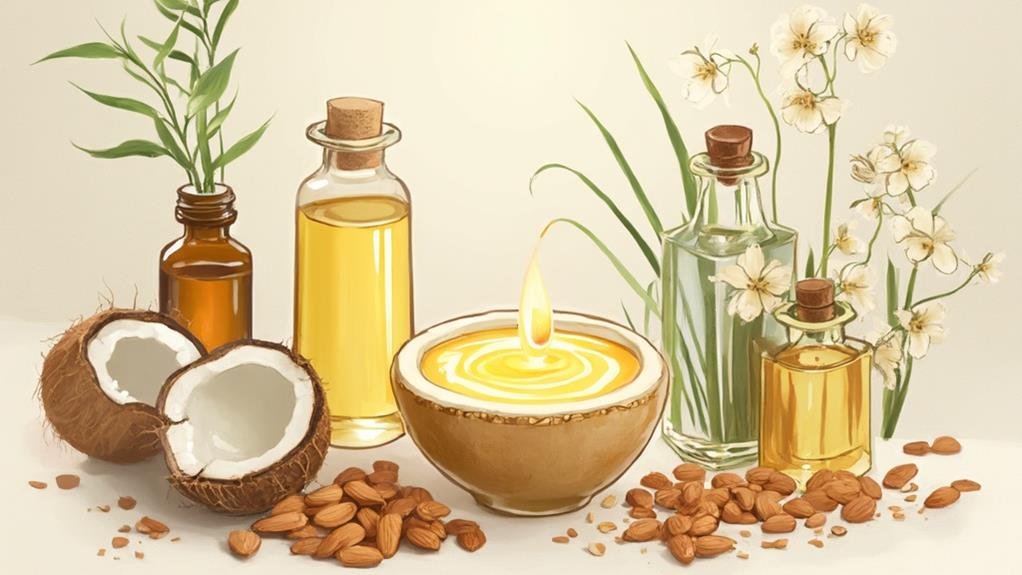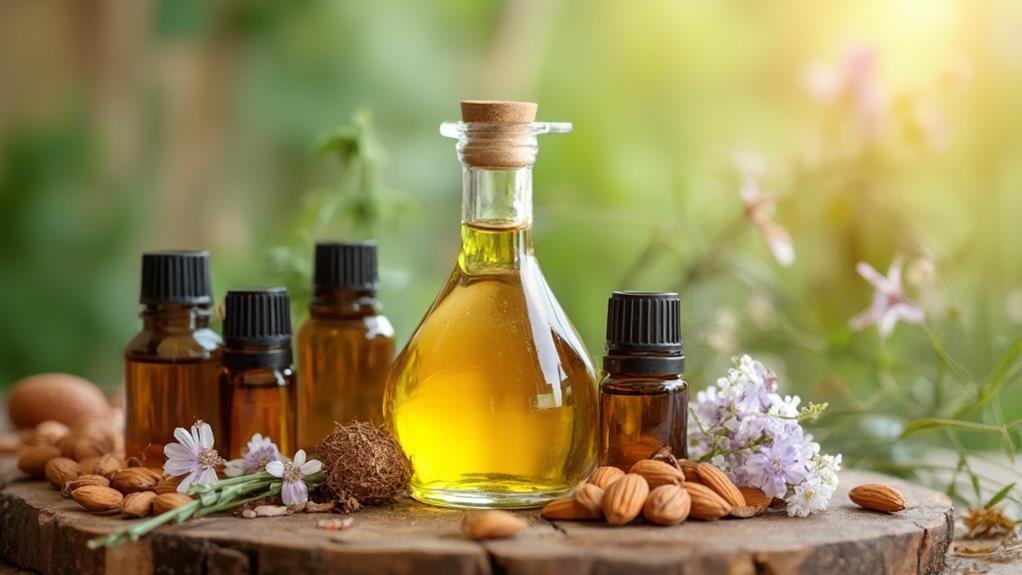Can You Mix Almond and Coconut Oil With Essential Oils?
You absolutely can mix almond and coconut oil with essential oils. This creates a custom blend that leverages the unique properties of each carrier oil.
Almond oil’s lightweight texture and rich vitamin profile pair well with coconut oil’s rich consistency and high saturated fatty acid content.
Benefits of Mixing Almond and Coconut Oil with Essential Oils
- Enhanced absorption
- Improved texture
- Increased shelf life
- Tailored therapeutic benefits

Properties of Almond and Coconut Oil
| Property | Almond Oil | Coconut Oil |
|---|---|---|
| Texture | Lightweight, non-greasy | Rich, creamy |
| Vitamin Content | Rich in vitamins A, B, and E | High in saturated fatty acids |
| Absorption Rate | Quick skin absorption | Medium absorption |
| Shelf Life | 12-18 months | Up to 2 years |
| Common Uses | Skincare, aromatherapy | Skincare, hair care |
Choosing the Right Essential Oils
Essential oils can be categorized into top, middle, and base notes to create a balanced blend.
In the context of essential oils, notes refer to the different layers or stages of scent that an essential oil releases over time. This is similar to how a perfume unfolds its fragrance in stages.

Top Notes: Uplifting (e.g., lemon, eucalyptus)
Middle Notes: Balancing (e.g., lavender, geranium)
Base Notes: Grounding (e.g., frankincense, sandalwood)
Considerations:
- Potency: Use potent oils sparingly (e.g., peppermint, tea tree)
- Viscosity: Affects blending and absorption
- Skin sensitivity: Check for potential irritants
Safety Precautions
- Patch Test: Always perform a patch test before using a new essential oil.
- Medical Conditions: Avoid certain oils if you have specific conditions (e.g., rosemary in high blood pressure).
- Pregnancy: Consult a healthcare professional if pregnant or breastfeeding.
Effective Mixing Ratios and Methods
Start with a 1-3% concentration of essential oils. This typically means adding 1-3 drops of essential oil per teaspoon of carrier oil.
| Application | Essential Oil Concentration | Drops per Teaspoon of Carrier Oil |
|---|---|---|
| Facial Use | 1% | 1 drop |
| Body Use | 2% | 2 drops |
| Therapeutic Use | 3% | 3 drops |
Steps:
- Use a clean, dark glass bottle.
- For single oil blends, fill the bottle 1/4 with carrier oil and add essential oils.
- For multiple oils, mix them in a small bowl first.
- Store in a cool, dark place.
Potential Allergic Reactions
Performing a patch test on a small area is crucial. Common signs of allergic reactions include redness, itching, swelling, or blistering. Discontinue use if any symptoms appear.
Storage and Use
Proper storage and handling are vital to maintaining the quality and safety of the blends.
Container Requirements:
- Airtight and non-reactive
- Specifically designed for storing essential oils
- Glass bottles with tight-fitting lids or dispensing caps
Safe Usage Guidelines:
- Dilute blends with a carrier oil
- Perform a patch test on a small skin area before extensive application
- Follow recommended usage rates and guidelines
Frequently Asked Questions
1. Can I Use Sweet Almond Oil and Bitter Almond Oil Interchangeably?
No, you should not use them interchangeably. Sweet almond oil is safe for skincare and is often used in cosmetic products due to its nourishing properties. In contrast, bitter almond oil contains amygdalin, which can release cyanide when metabolized, making it toxic and unsuitable for topical use.
2. Does Mixing Carrier Oils Affect Shelf Life?
Yes, mixing carrier oils can affect the shelf life of the blend. The overall shelf life is determined by the least stable oil in the mixture. For example, if you mix a carrier oil with a shorter shelf life (like certain nut oils) with one that lasts longer (like coconut oil), the resulting blend will spoil at the rate of the less stable oil.
3. Can I Use Fractionated Coconut Oil With Essential Oils?
Absolutely! Fractionated coconut oil is an excellent carrier oil for essential oils. It remains liquid at room temperature, has a long shelf life, and is easily absorbed by the skin without leaving a greasy residue. This makes it a popular choice for creating blends.
4. Will Mixing Almond and Coconut Oil Change Their Individual Benefits?
Mixing almond and coconut oil will not change their individual benefits; instead, they will complement each other. For instance, almond oil’s lightweight texture enhances absorption, while coconut oil adds moisturizing properties. Together, they create a blend that combines the benefits of both oils.
5. Can I Add Vitamin E Oil to My Blend?
Yes, you can add Vitamin E oil to your almond and coconut oil blend. Vitamin E acts as a natural antioxidant, which can help extend the shelf life of your oils by preventing oxidation. It also offers additional skin benefits, such as hydration and protection against environmental damage. A typical recommendation is to start with about 1% of the total volume of your blend.






